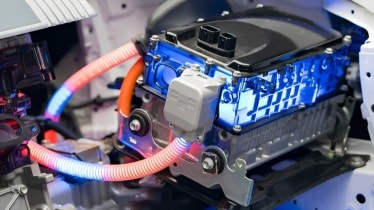By Anurag Choudhary
Electric vehicle technology is poised to undergo a significant transformation, driven by the global push towards sustainability and carbon neutrality. The primary component of electric vehicles, as well as portable consumer electronics and grid-scale energy storage is Lithium-Ion Battery (LiB). Compared to other rechargeable battery technologies, LiB demonstrates remarkable attributes such as high energy densities, low self-discharge, and no memory effect, which makes it a primary battery choice for these applications.
LiB (or battery pack) is made by packaging one or more individual cells together. Lithium-ion cells are composed of four main components: anode, cathode, electrolyte, and separator. Anode (or the negative electrode) in LiB is typically constructed using graphite, which is coated on copper foil. Graphite is a crystalline solid form of carbon with a black/grey colour and a metallic sheen.
The evolution of battery anode materials
Graphite’s Dominance: In the early phases of mass production for LiB, graphite emerged as the consistent preference for the industry’s primary anode material. Graphite has traditionally been favoured as the active component in negative electrodes because of its capacity to efficiently intercalate lithium ions within its layers. This characteristic ensures a sustainable electrochemical performance over multiple cycles. However, even though graphite continues to be the preferred material for the majority of anodes because of its cost-effectiveness and strong reversibility, its moderate intrinsic specific capacity of 350-360 mAh/g constrains the advancement of next-generation batteries for potential applications.
Alternative to Graphite – Pure Silicon
One of the most promising contenders for the upcoming phase of improvement is silicon. This element stands out for its eco-friendliness, cost-effectiveness and its status as the second most abundant element in the Earth’s crust. These characteristics make it an excellent candidate for receptered lithium ion, resulting in a remarkable specific capacity of up to 3578 mAh/g, nearly ten times higher than graphite.
When utilized as an active anode material in Li-ion batteries, pure silicon demonstrates a substantial volumetric expansion – approximately 10 times that of graphite. This is a notable drawback, as the volumetric swelling leads to “cracking” of silicon electrodes, rendering them unsuitable for LiB applications.
The solution: Silicon Graphite (SiG) anodes:
The solution lies in combining silicon and graphite as an anode material, referred to as Silicon Graphite (SiG). The infusion of Silicon into Graphite presents a remedy to the discharge capacity limitations of conventional graphite anode as also to the excessive volumetric expansion of silicon. Extensive research has been dedicated to investigating this combination, involving variations in the percentage of silicon mixed with graphite. SiG with around 8-10% silicon content offers several benefits, namely:
Enhanced discharge capacity: An approximate discharge capacity of 450-650 mAh/g, which is 1.25-2 times that of a conventional graphite anode.
50% Higher Cell Energy Density: This enables longer range of distance covered by an EV in a single charge
Enabling fast charging
However, the challenge lies in effectively integrating silicon with graphite, aligning their synergies within the confines of cost structures.
Silicon graphite’s potential and growing role:
With the ongoing technological advancements and the escalating global demand for electric vehicles, Silicon Graphite (SiG) is anticipated to assume a pivotal role in the future of the lithium-ion battery industry.
Morgan Stanley foresees an impressive growth trajectory, projecting a 50% market penetration of silicon-based anodes by 2030 – an exponential rise from the current 1%.
This transformative shift towards Silicon Graphite underscores its potential to revolutionize battery performance and pave the way for a more sustainable and efficient EV landscape.
The author is CMD & CEO of Himadri Speciality Chemical.
Disclaimer: Views expressed are personal and do not reflect the official position or policy of Financial Express Online. Reproducing this content without permission is prohibited.
